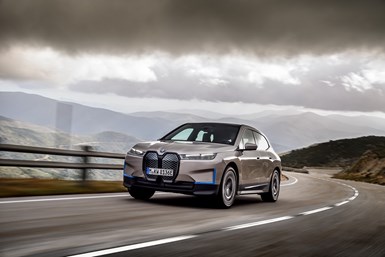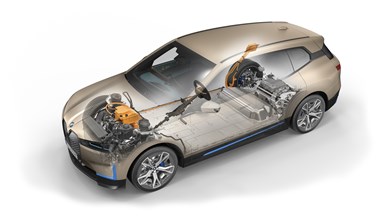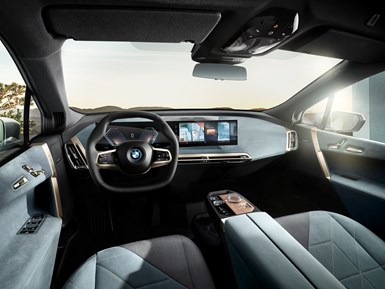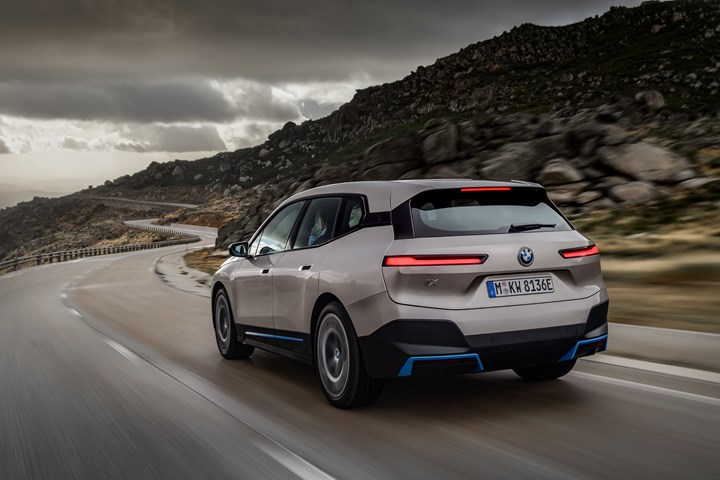BMW Unveils the iX EV SUV
While it isn’t going to be available until early 2022, BMW wants to show that it is in the lux EV SUV space, too
#hybrid #aluminum
“The BMW Group is constantly striving to re-invent itself. That is a central element of our corporate strategy,” Oliver Zipse, Chairman of the Board of Management of BMW AG, said on the occasion of the unveiling of the BMW iX, an electric vehicle, a crossover, that is functionally based on a new scalable architecture that the company will use for other EVs going forward and visually based on the BMW Vision iNEXT concept.

The BMW iX. An electric ute. Going into production in 2021; available in the U.S. in ‘22. (Images: BMW)
The “i” goes to the point of the iBrand that the company has had, which included the i8 hybrid until the plug was pulled on that low-selling model and the i3 EV, which is still out there, although somewhat difficult to discern, as only 4,854 were sold in the U.S. in 2019 (which is better than the 1,102 i8s moved).
Note that the iX is a real car in that it is scheduled to go into production in the second half of 2021 at the plant in Dingolfing and to be available in the U.S. market in early 2022.
A cautionary quote
Adrian van Hooydonk, Senior Vice President BMW Group Design, said, “The BMW iX offers a mobile living space in which people will feel at ease, where the car’s intelligence is only there when you need it.”
An “Ultimate Driving Machine” shouldn’t resemble a house in any way, shape or form.
Speaking of Driving Machines
Notably, while BMW goes on at some length about the optional panoramic glass roof (e.g., it is the biggest ever in a BMW vehicle; it features a steel frame that holds two panels of laminated glass and three layers of film; it uses polymer dispersed liquid crystal so that it provides electrochromic shading rather than that provided by a piece of fabric), details about the propulsion system are minimal.

A new platform developed for the iX will be also used for future models.
It is the fifth generation of the company’s eDrive tech. There are two electric motors. It will produce “by the most recent calculations” produce about 500 hp. It should be able to go from 0 to 62 mph in under 5 seconds.
The range is about 300 miles.
Charging considerations
DC fast charging at up to 200 kW. . . going from 10 to 80% capacity in under 40 minutes. . .about 75 miles of range achieved in about 10 minutes of charging.
EVgo is the fast charging network of choice for BMW.
For those charging at Level 2, plan on about 11 hours to go from 0 to 100% state-of-charge.
Hat-tip to Tesla Interior Design Team?
Domagoj Dukec, Vice President, BMW Design, said, “In the process [of executing the interior design], we took particular care to create a modern, warm and minimalist interior design with a very spacious feel.”
Tesla interiors have been known for their minimalist approach, especially as regards the IP.
Hat-tip to Cadillac Interior Design Team?
The iX has a curved display consisting of a 12.3-inch driver information display (think of this as being the gauge cluster) and a 14.9-inch control display (think of this as infotainment) that are combined in a single curved driver display.

Big screen. And check the hexagonal steering wheel.
Sounds like something we’re seeing right now in the 2021 Cadillac Escalade.
Mixed material construction
The “i” vehicles provided BMW with extensive experience in utilization of carbon-fiber reinforced plastic (CFRP) components, which is being brought forward to the iX. It will feature CFRP in the side frame, roof frame, cowl panel, rain channels and rear window frame.
They are describing this execution as the “Composite cage.”
There is an aluminum space frame.
Right to repair?
Here’s something different: The customer can’t open the hood. Something goes wrong, then it is only certified technicians who can get in there to access the power electronics and drive system.
However, the customer can add washer fluid. The BMW roundel opens for the fluid.
Slippery
The vehicle has a coefficient of drag of 0.25. “Wait,” you might think, “the Lucid Air is at 0.21”—but remember, this is a crossover (or a “sports activity vehicle” in BMW-speak).
Among the ways this is achieved include flush door handles, frameless windows, slim side mirrors, a front air management system (the kidney grille and air intakes at the bottom of the front bumper are sealed, but opened should cooling air be required, underbody countermeasures including the smooth aluminum battery case, and aerodynamic wheels.
The Sport package adds even more. Vertical Air Curtains and Air Blades to channel air; Air Performance Wheels with inserts between the spokes.
Final word
Adrian van Hooydonk: “The BMW iX shows how we can give new technologies a very modern and emotional design. The car is technologically complex, but it feels very clear and uncomplicated.”

All manner of aero, including a notable tumblehome.
RELATED CONTENT
-
Mahindra Automotive in America
Rick Haas has an impressive automotive resume, having held positions at Ford and Tesla and currently as the president and CEO of Mahindra Automotive North America.
-
On Ford Maverick, Toyota Tundra Hybrid, and GM's Factory Footprint
GM is transforming its approach to the auto market—and its factories. Ford builds a small truck for the urban market. Toyota builds a full-size pickup and uses a hybrid instead of a diesel. And Faurecia thinks that hydrogen is where the industry is going.
-
2019 Honda Insight
One of the things that rarely gets the amount of attention that it should in a typical “car review” is the fact that for a considerable amount of time drivers are not “getting on the throttle” because for a considerable number of drivers, they’re “dwelling on the binders,” a.k.a., sitting with their foot depressed on the brakes, perhaps lifting every now and then in order to nudge forward in traffic.


.jpg;width=70;height=70;mode=crop)






